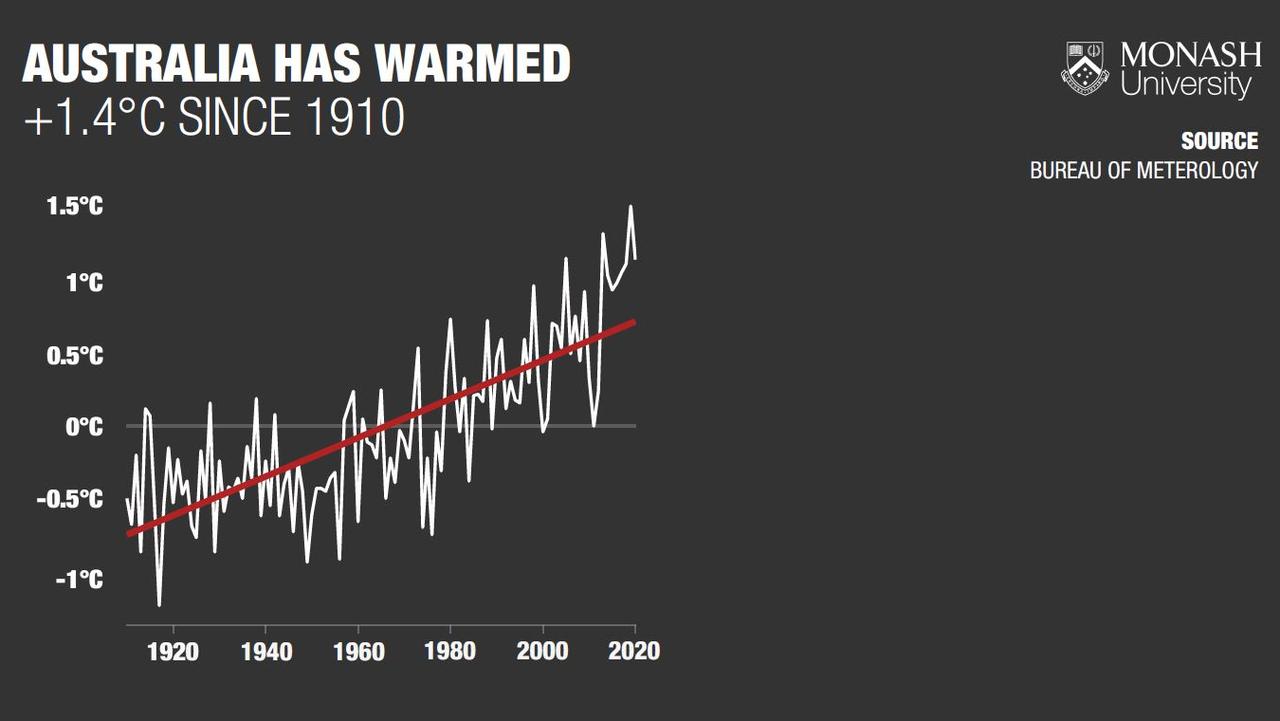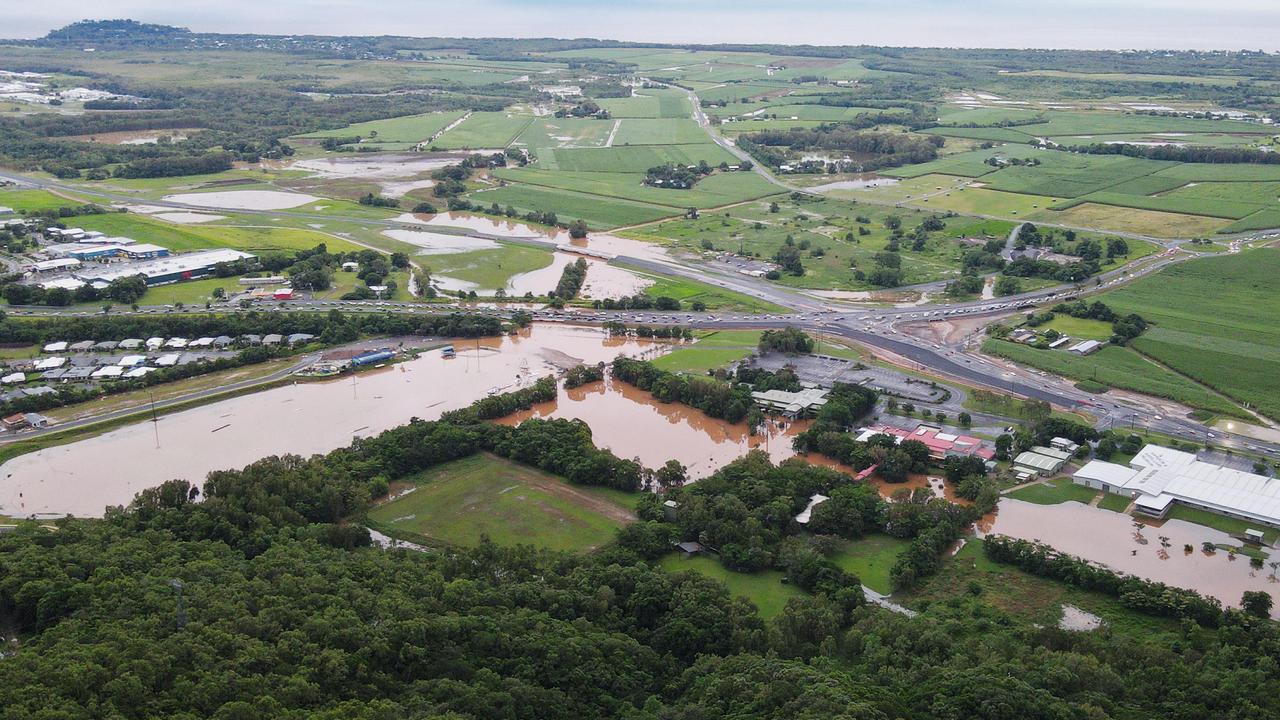Landmark report confirms Australia is 1.4C warmer and how different regions are being impacted by climate change
A new report from the United Nations has confirmed Australia has warmed by 1.4C and the devastating impacts this is having.

A landmark new report has confirmed Australia has already warmed 1.4C with impacts already seen in many regions, particularly in the southern parts of the country.
Scientists have observed changes to the Earth’s climate in every region in the world and across the whole climate system, according to the latest Intergovernmental Panel on Climate Change (IPCC) report, released on Monday night.
The report from the United Nations body draws on the latest developments in modelling and science, stating it is “unequivocal” that human influence has warmed the atmosphere, ocean and land.
“Each of the last four decades has been successively warmer than any decade that preceded it since 1850,” the report states.
The report said the world had warmed by an average of 1.1 degrees celsius, and using an “intermediate” approach that aligned most closely with current climate pledges, warming could reach up to 1.8C within 20 years (2040) and up to 2.5C within 40 years. By 2100 temperatures could be 3.5C higher.
Even under the lowest emissions scenario, temperatures would rise by up to 1.7C within the next 20 years, and could reach 2C within 40 years.
Under higher emissions scenarios, warming could reach as high as 1.9C within 20 years.
United Nations secretary-general Antonio Guterres said the internationally agreed threshold of 1.5C was “perilously close”.
“We are at imminent risk of hitting 1.5 degrees in the near term,” he said.
RELATED: Australia’s extreme weather future revealed

“The only way to prevent exceeding this threshold is by urgently stepping up our efforts, and pursuing the most ambitious path. We must act decisively now to keep 1.5 alive.”
Australia has experienced warming of 1.4C — much higher than the global average of 1.1C — that has led to more hot extremes and less rainfall during winter in southern Australia, as well as many other impacts.
“This report shows Scott Morrison’s 2030 targets are a death sentence for Australia,” Greens leader Adam Bandt said.
Impacts on Australia
Not every country or region is warming at the same rate, for example New Zealand only experienced 1.1C of warming compared to Australia’s 1.4C. Meanwhile, warming in the Artic is twice as high as the average.
This is because the global figure of 1.1C also includes the ocean, which generally warms slower than the land so most countries have warmed more than the average.
Further modelling by CSIRO and the Bureau of Meteorology found that individual states in Australia are warming faster than others.
Queensland and South Australia are warming at 1.5 times the global average, while New South Wales/Australian Capital Territory, Northern Territory and Western Australia are warming at 1.4 times, Victoria is warming at 1.2 times and Tasmania is warming at the same rate as the average.
RELATED: Australia’s emissions target falls ‘well short’
According to the IPCC, the Australasia region, which includes New Zealand, has experienced:
• More hot extremes
• Higher rates of sea level rise than the global average
• The retreat of sandy shorelines in many locations
• Decrease in snow cover and depth
• Increase in the frequency of extreme fire weather days and a longer fire season.
• Less rainfall during winter in southern Australia.
Many of these impacts are expected to get worse, including:
• More heavy rainfall, river floods, sand storms and dust storms
• Increase in intensity, frequency and duration of fire weather events
• More coastal flooding as sea levels rise
• Continuing decrease in snow cover and depth.
These impacts could be devastating for many Australians.
“There is high confidence that sea level will continue to rise, and well beyond the end of this century,” Dr James Goldie of the Monash Climate Change Communication Research Hub said.
“This will contribute to increased coastal flooding and shoreline retreat along sandy coasts throughout Australia.”
Climate consultant at the hub, Neil Plummer, said climate extremes would amplify the challenges many Australians already faced.
“Our farmers and water managers already have significant challenges through our high climate variability and the extremes of droughts and floods” he said.
RELATED: Report details catastrophic outcome of 3C warming

The IPCC report found different regions of Australia were feeling different impacts from the warming.
Northern Australia
• Includes areas in the top half of Australia, in Western Australia, Northern Territory and Queensland
• Has already seen more heavy rainfall and a decrease in droughts and tropical cycles
• Could see increase in heavy rainfall and river flooding
• In the future there could be less cyclones but these may be more severe when they do happen.
Central Australia
• Includes some of the country’s western coastline, as well as parts of South Australia, Northern Territory, New South Wales and Western Australia
• Warming will be worse than in coastal regions
• Could see more heavy rainfall in the future and river flooding.

Southern Australia
• Includes Victoria, Tasmania and parts of South Australia and Western Australia
• Has already experienced less rainfall and an increase in droughts
• In the future could see less average rainfall, particularly in winter
• Could face increase in aridity, and increase in droughts
• In the southwest part of the region there has already been a significant decrease in rainfall and an increase in drought. Rainfall is expected to continue decreasing under all future scenarios.
Eastern Australia
• Includes NSW and southern areas of Queensland
• Less rainfall expected in winter but more extreme rainfall events such as flooding could occur
• Droughts are expected to increase if 2C of global warming is reached.
Australia must act on ‘red code for humanity’
The report is likely to place increasing pressure on countries like Australia to increase its carbon reductions targets.
Australia has pledged to reduce emissions by 26-28 per cent below 2005 levels by 2030.
But more recently, there has been pressure for Australia to adopt a net-zero by 2050 target, which other countries like the United States, France, UK, Germany, Canada, South Africa, South Korea and Japan have all adopted.
The IPCC has confirmed the importance of this target, noting in its report that both the 1.5C and 2C warming limits will be exceeded during this century, unless emissions are reduced to net zero around or after 2050.
“The last time global surface temperature was sustained at or above 2.5C higher than 1850–1900 was over three million years ago,” the report states.

Australia will expected to update its short-term emissions targets when it attends the Conference of the Parties in Glasgow in November.
So far Prime Minister Scott Morrison has resisted committing to a higher target, saying only that the government had a goal to achieve net zero emissions “preferably by 2050”.
The International Energy Agency (IAE), has already warned all fossil fuel development and exploration must cease this year if the goal of limiting global warming to 1.5 degrees celsius is to be met.
Greens leader Adam Bandt said the report must now force the government to double or triple the country’s 2030 targets. It wants a target of net zero emissions by 2035 and 75 per cent cuts by 2030.
“Delay is the new denial, we can’t wait until 2050, and anything less than 75 per cent emissions cuts by 2030 means giving up on the 1.5 degree goal in the Paris Agreement,” he said.
“Exceeding 1.5 degrees of warming means that we will lose the Great Barrier Reef, have widespread and sustained drought, more extreme weather events, and catastrophic bushfires will become the norm.
“The rest of the world understands that if we don’t do more by 2030, we all go over the climate cliff, so the Liberals’ 2030 denial and Labor’s 2030 silence are putting Australian lives at risk.”
UN chief Mr Guterres said described the IPCC report as a “code red for humanity”.
“The alarm bells are deafening, and the evidence is irrefutable: greenhouse gas emissions from fossil fuel burning and deforestation are choking our planet and putting billions of people at immediate risk.
“Global heating is affecting every region on Earth, with many of the changes becoming irreversible.”




